You’ll uncover how Japanese minimalist design can alter your living room into a peaceful sanctuary that reflects centuries-old principles of Zen aesthetics. From the strategic placement of natural light to the thoughtful selection of organic materials, these 18 designs showcase the perfect balance between form and function. Whether you’re redesigning your space or seeking inspiration, these carefully curated examples will guide you through the essential elements of creating your own serene retreat.
Natural Light and Open Spaces: The Foundation of Zen Design

Every successful Japanese minimalist living room begins with the adept integration of natural light and open spaces, creating an environment that instantly soothes the soul.
You’ll find that strategically placed windows and sheer curtains flood your space with natural illumination, while uncluttered pathways and functional furniture enhance the Zen-like ambiance.
Your connection to nature strengthens through large windows, promoting a sense of boundless spaciousness.
Embracing Wabi-Sabi Through Minimalist Furniture
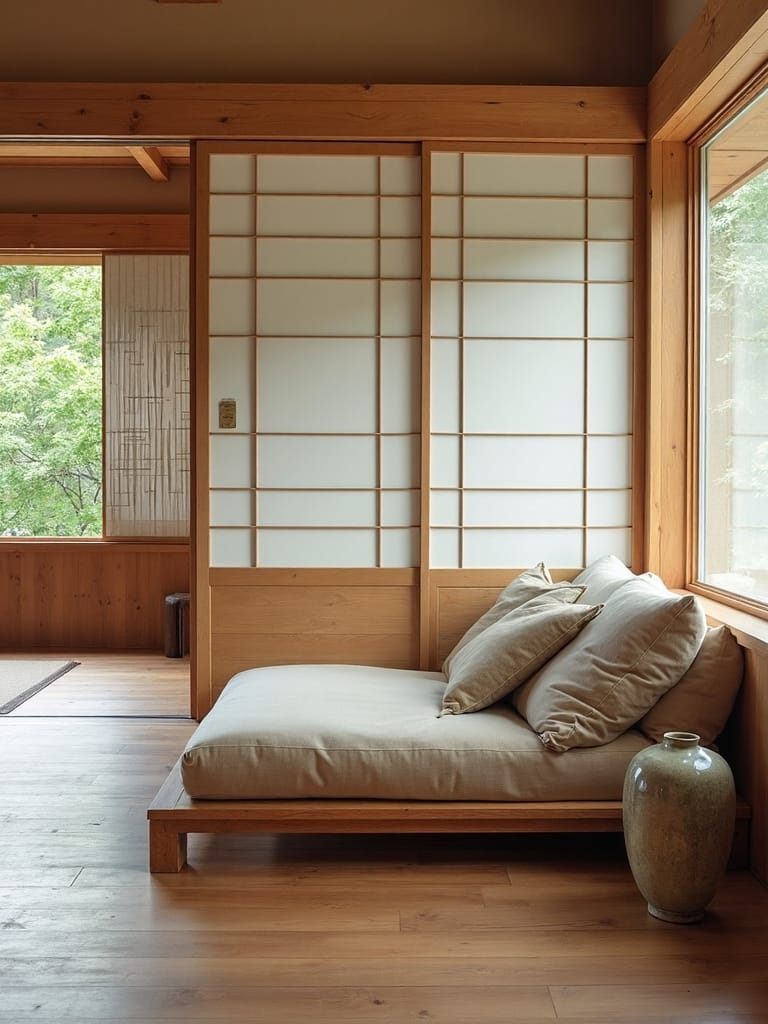
Three essential principles of wabi-sabi come to life through minimalist Japanese furniture, altering your living room into a sanctuary of natural beauty and tranquility.
Choose pieces that showcase natural materials like oak and walnut, embracing their clean lines and natural imperfections. You’ll find serenity in low-profile sofas and handcrafted wooden tables that develop a beautiful natural patina over time, creating an authentically simple, serene atmosphere.
The Art of Decluttering: Creating Space for Tranquility

When you begin your expedition toward Japanese minimalism, decluttering becomes the foundation for creating a tranquil living space that nurtures both mind and spirit.
Incorporating Natural Materials and Textures
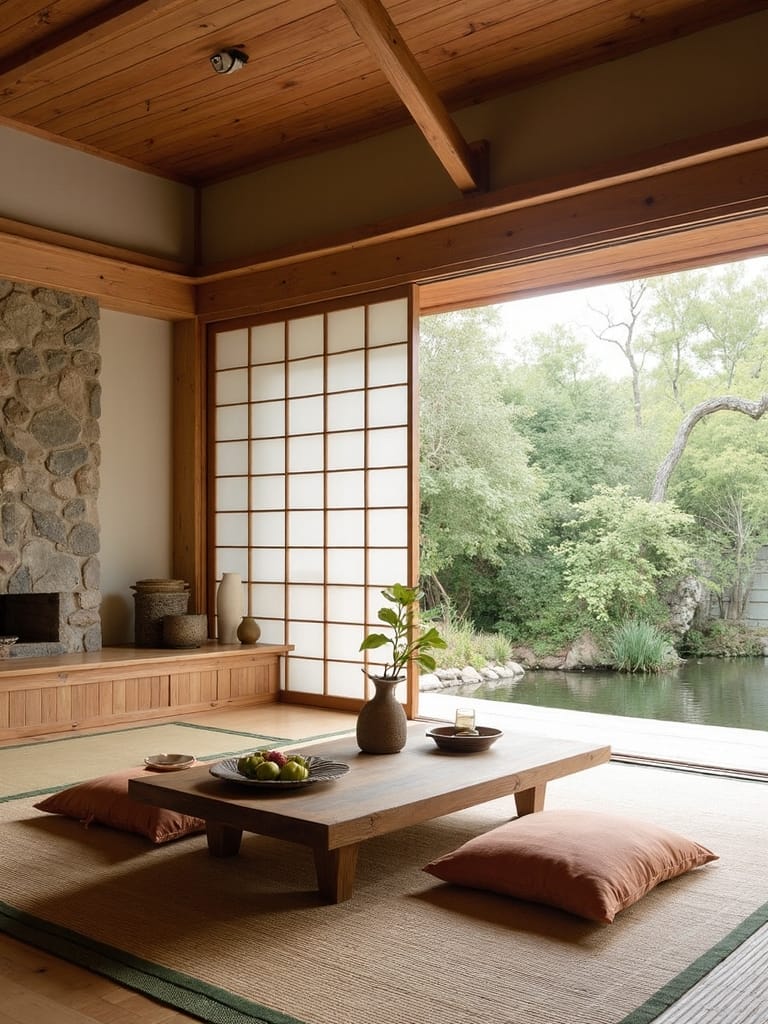
Natural materials and textures form the cornerstone of Japanese minimalist living rooms, creating spaces that feel both grounded and serene. You’ll find wooden furniture and bamboo accents working harmoniously with stone tiles to bring nature indoors.
Complete your space with natural textiles like linen and cotton, embracing the wabi-sabi philosophy through raw, unfinished elements that celebrate organic imperfection.
Shoji Screens and Room Dividers
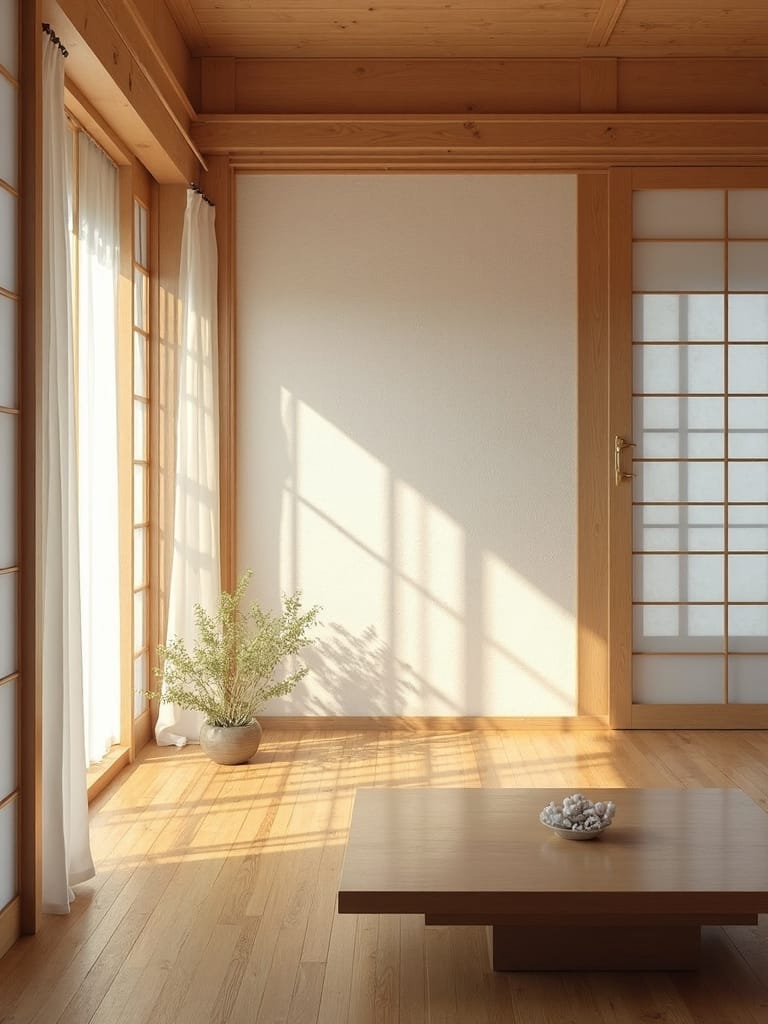
Shoji screens stand as refined [DESIGNER] components that define Japanese minimalist living spaces with elegance and intention.
You’ll find these versatile room dividers create a serene ambiance while maximizing flexibility in your living area. Their delicate frames and translucent paper panels allow natural light to filter through, perfectly complementing other natural materials and maintaining the Zen-inspired aesthetic of your minimalist design.
Traditional Tatami Mat Flooring Options
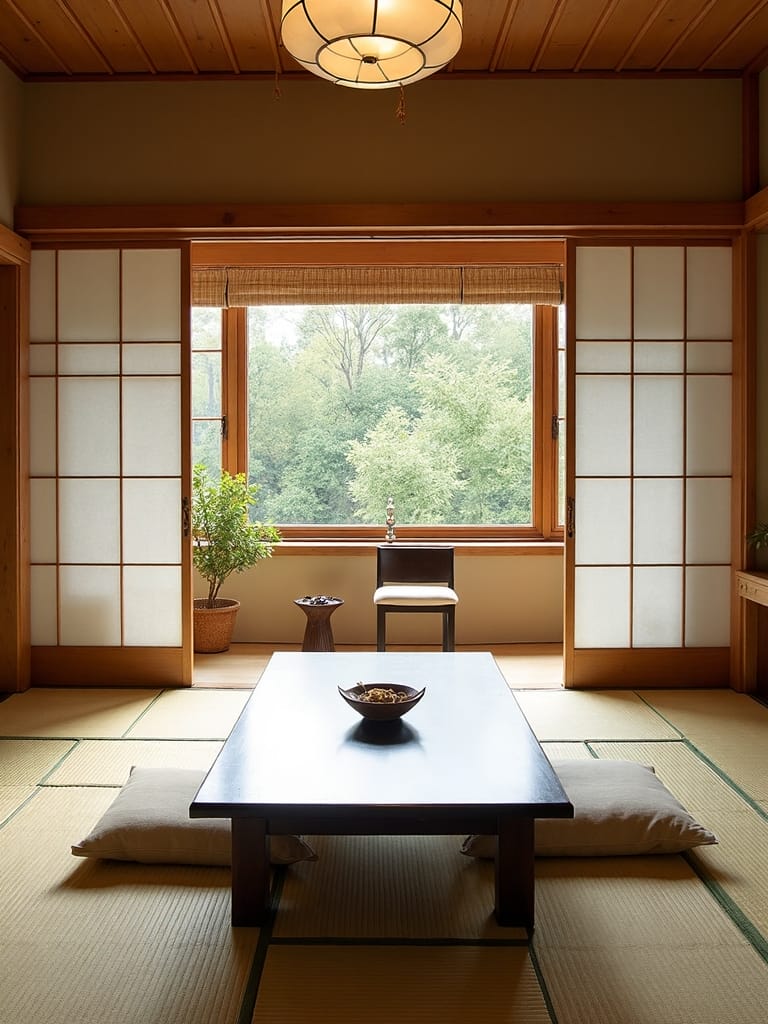
Traditional tatami mat flooring serves as the foundation of authentic Japanese minimalist living rooms, bringing natural warmth and cultural significance to your space. These natural materials, sized at 3 x 6 feet, create a flexible layout that promotes harmonious balance and a strong connection to nature.
You’ll appreciate how tatami mats offer thermal insulation while complementing your minimalist design with their neutral color palette and grounding presence.
Low-Profile Seating Arrangements
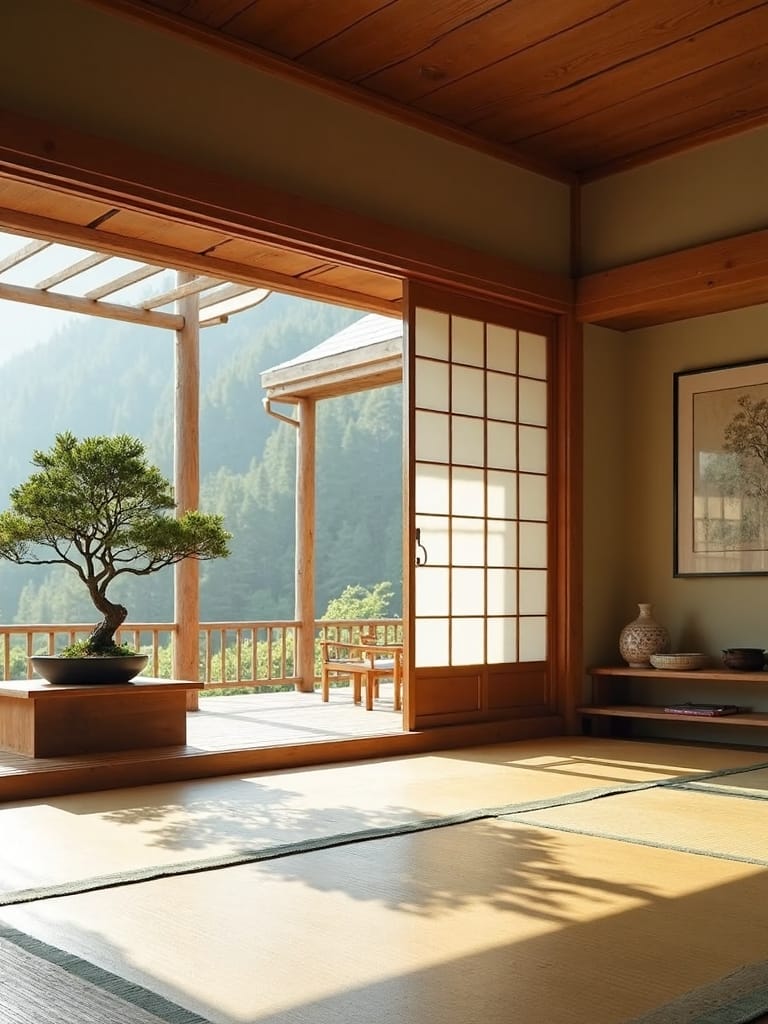
When designing a Japanese minimalist living room, low-profile seating forms the heart of your space’s tranquil atmosphere. Select platform-style furniture with clean lines and simple upholstery to embody zen principles while creating a serene natural space.
You’ll find that placing chairs, sofas, and ottomans closer to the ground, along with versatile floor cushions, enhances the room’s modern elements while maintaining light, unobstructed sightlines.
Neutral Color Palettes and Earth Tones
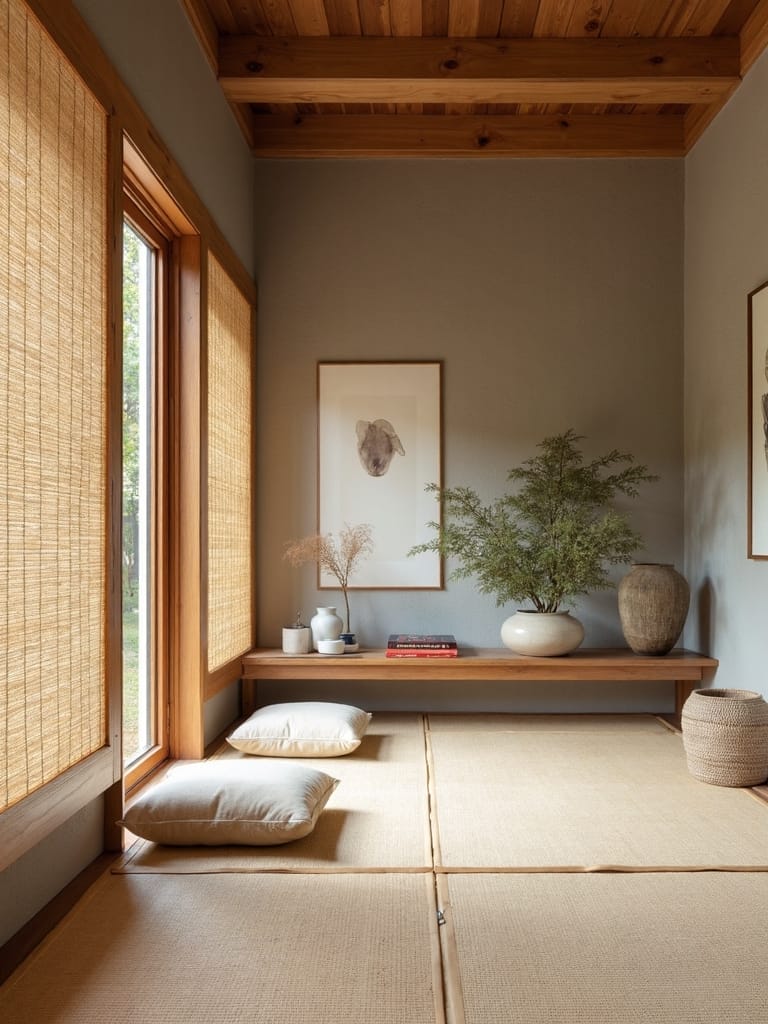
A carefully curated neutral color palette serves as the foundation for Japanese minimalist living rooms, creating an atmosphere of tranquility and balance.
You’ll find that combining whites, grays, and earthy tones allows your minimalist furniture’s clean lines to shine. Incorporate natural materials like wood and stone to enhance the connection to nature, while strategic touches of black add depth to your tranquil ambiance.
Indoor Plants and Natural Elements
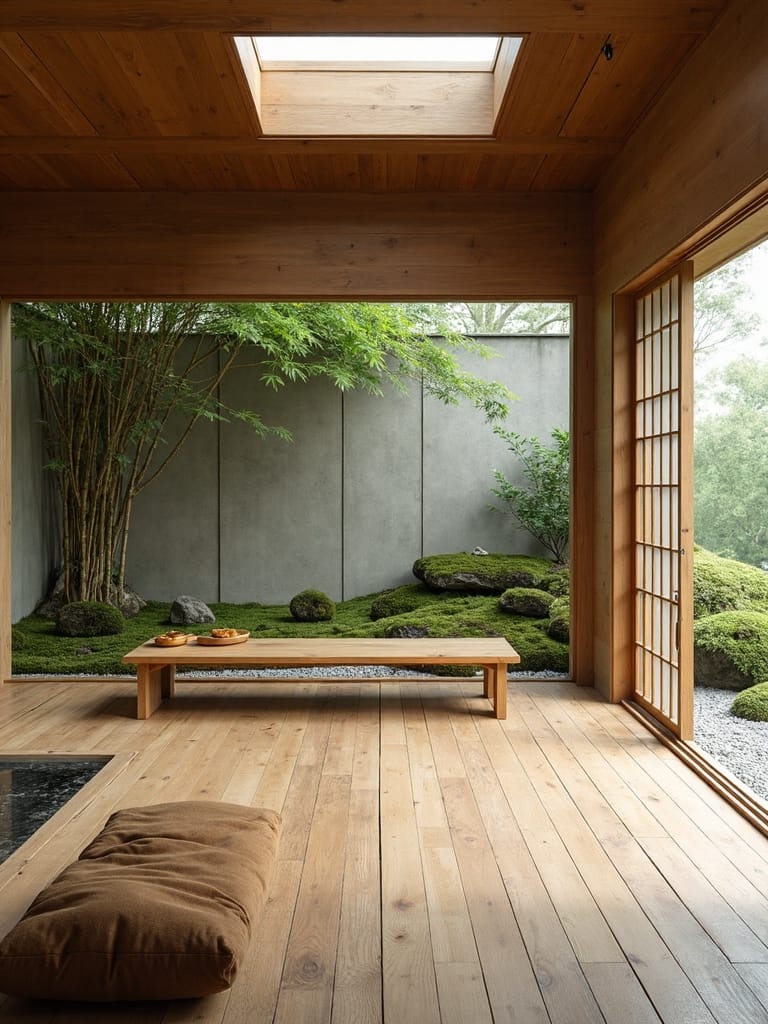
Bringing natural elements into your Japanese minimalist living room creates a seamless bridge between indoor serenity and outdoor vigor. You’ll find that strategically placed indoor plants complement natural wood features while purifying the air.
Enhance your Zen elements by positioning greenery near natural light sources, creating a sense of tranquility. These living accents perfectly balance minimalist design with your connection to nature.
Mindful Lighting Solutions

Light flows seamlessly from nature into your minimalist Japanese living room, working in harmony with your indoor greenery.
Large windows and shoji screens welcome natural light while strategically placed mirrors amplify its gentle glow throughout your space.
Create layers of warm lighting with dimmable floor and table lamps, then enhance the serene atmosphere with softly flickering candles and essential oil diffusers.
Balance and Symmetry in Room Layout
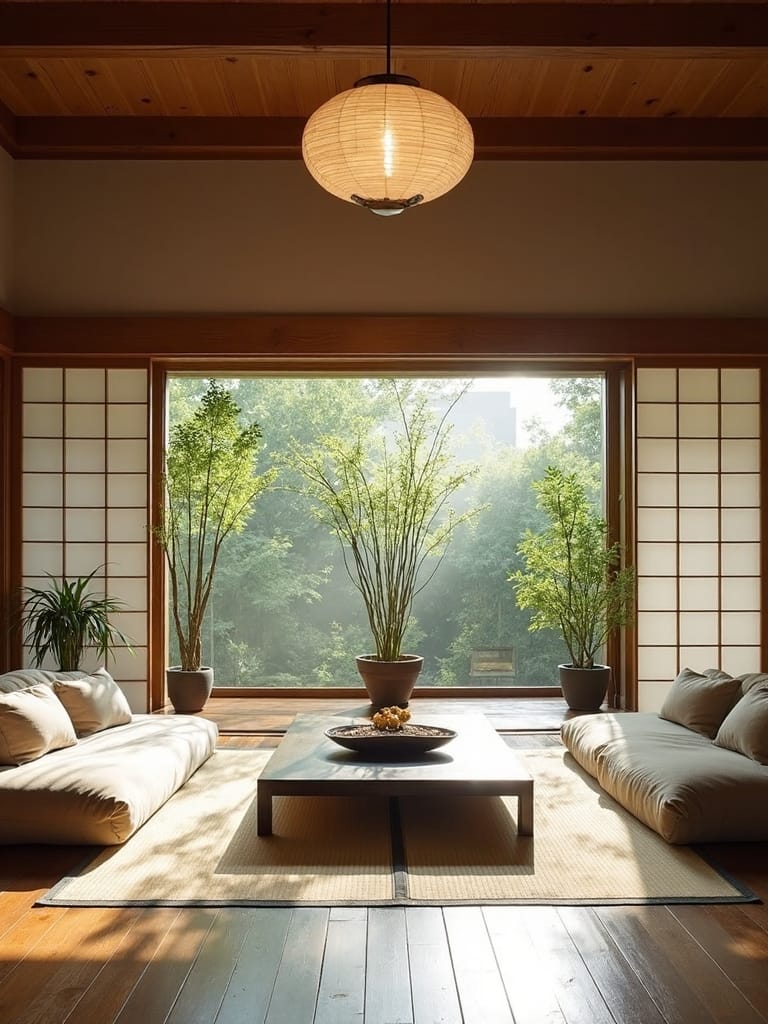
When designing your Japanese minimalist living room, the careful arrangement of furniture and decor creates a harmonious flow that’ll instantly calm your spirit. By embracing the Zen philosophy of balance, you’ll want to position your furniture symmetrically while incorporating natural materials and light.
Consider the wabi-sabi approach by creating equal visual weight throughout your space, allowing the minimalist aesthetic to shine through purposeful placement and thoughtful negative space.
Multi-functional Storage Solutions
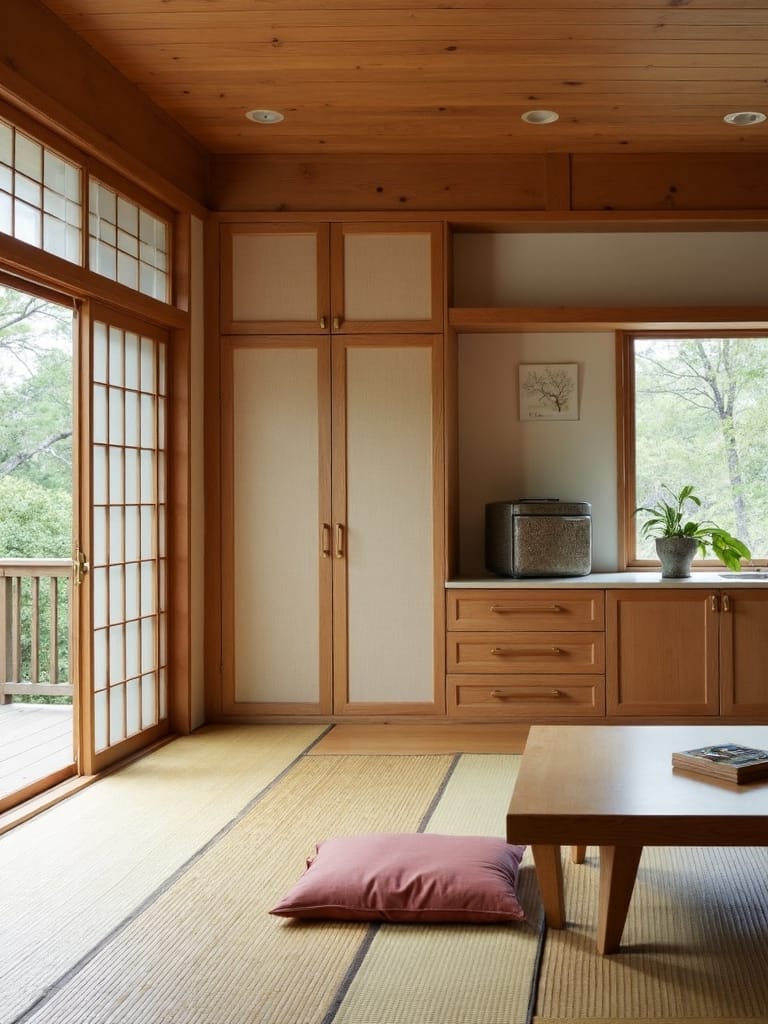
A well-balanced Japanese minimalist living room needs smart storage solutions that maintain its serene atmosphere. You’ll find multi-purpose furniture like ottomans with hidden storage and low-profile shelving units perfect for decluttering surfaces while preserving clean lines.
Consider wall-mounted storage and flexible partitions like shoji screens, along with functional storage coffee tables to maximize your space’s efficiency without compromising the minimalist aesthetic.
The Role of Water Features
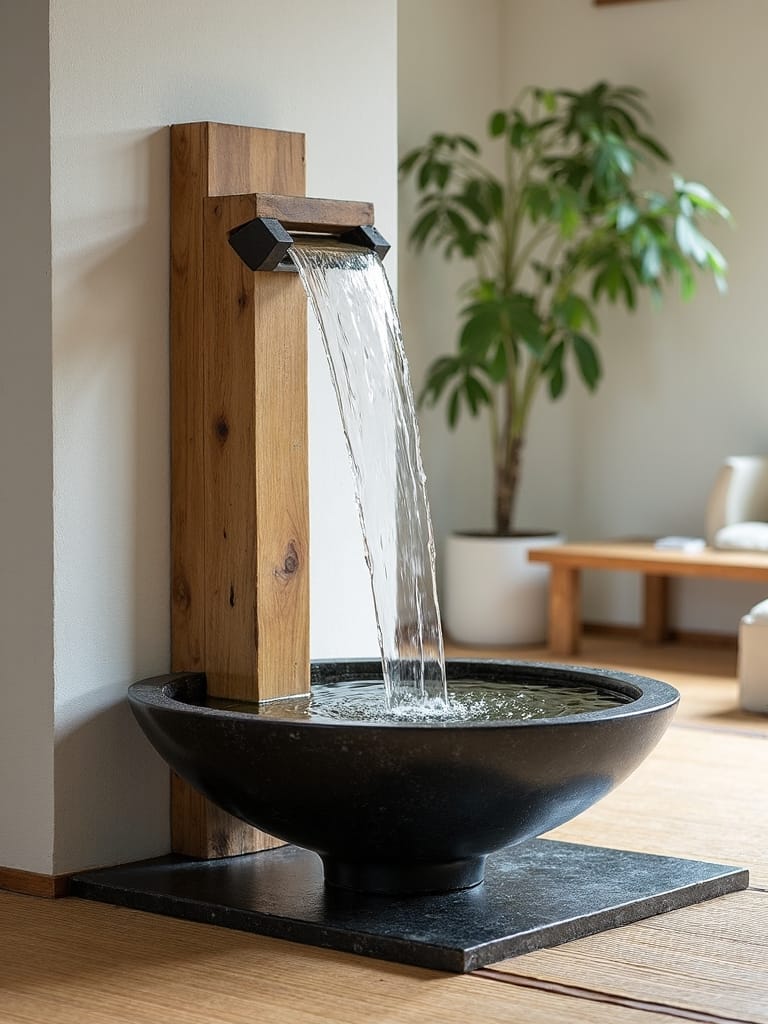
In Japanese minimalist design, water features serve as powerful tools for creating a meditative sanctuary within your living room. By incorporating a small water feature with natural wood elements, you’ll maximize natural tranquility and embody the essence of Japanese minimalism.
Position your fountain near seating to enhance the sense of calm, while river rocks and bamboo accents bring an authentic sense of peace to your space.
Minimalist Art and Wall Decor
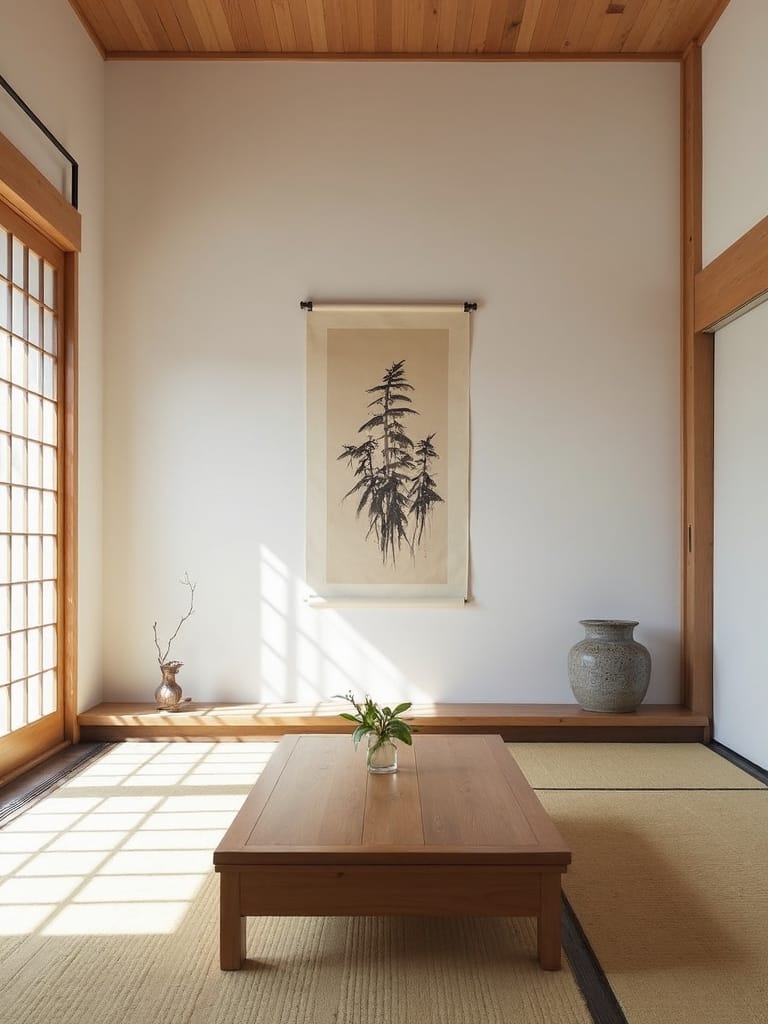
Since Japanese minimalism celebrates the beauty of simplicity, your wall decor choices play a crucial role in establishing a serene living room atmosphere.
Select minimalist art pieces like abstract paintings or calligraphic works in monochromatic or earth tones. Frame them with natural materials such as wood or stone, and position them strategically to enhance structural elements.
Remember to maintain ample negative space around each piece to create that perfect zen balance.
Creating Meditation Corners
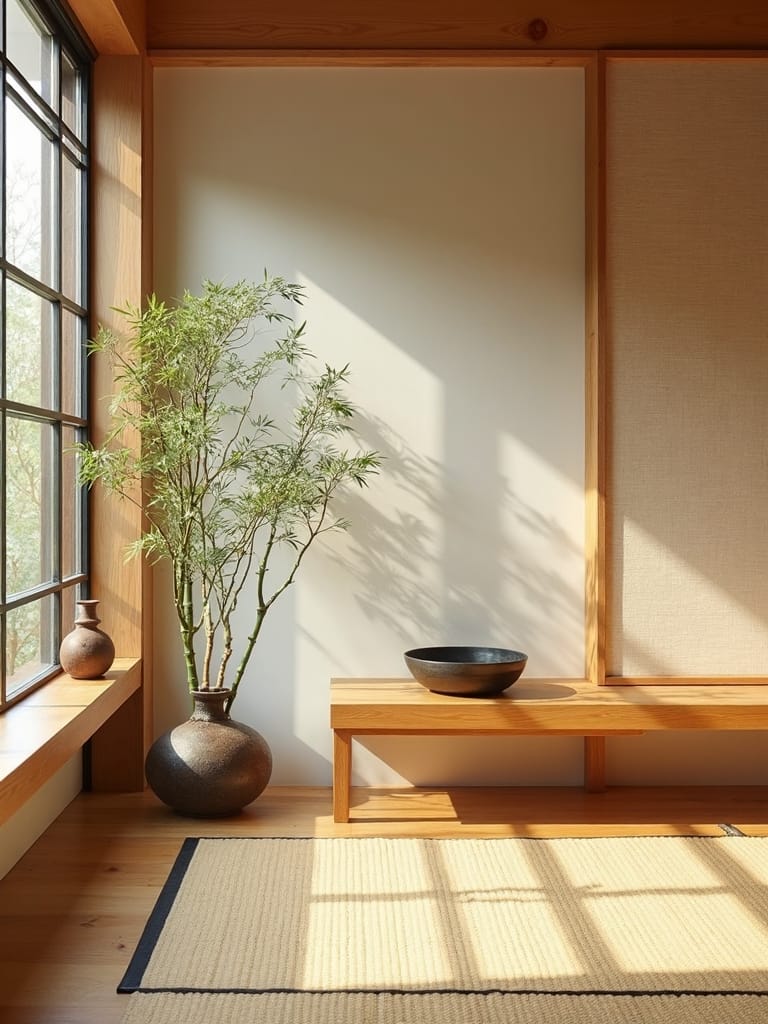
Minimalist wall decor sets the stage perfectly for the next element of Japanese living room design – your personal meditation space.
Create a tranquil corner using natural materials like bamboo shoji screens and zabuton cushions. You’ll want to allow natural light to flow while incorporating modern elements like a small indoor Zen garden or water feature.
Position traditional Japanese elements, like a Buddha statue, to enhance your peaceful natural space.
Organic Shapes and Clean Lines

While Japanese design celebrates simplicity above all else, organic shapes and clean lines form the foundation of a truly minimalist living room.
You’ll find that natural materials like wood and stone complement minimalist silhouettes perfectly. Choose multifunctional furniture with streamlined profiles to maximize your space, and select curated accessories that feature gentle curves and geometric forms. These elements work together to create a zen-like atmosphere that’s both beautiful and purposeful.
Blending Indoor and Outdoor Living
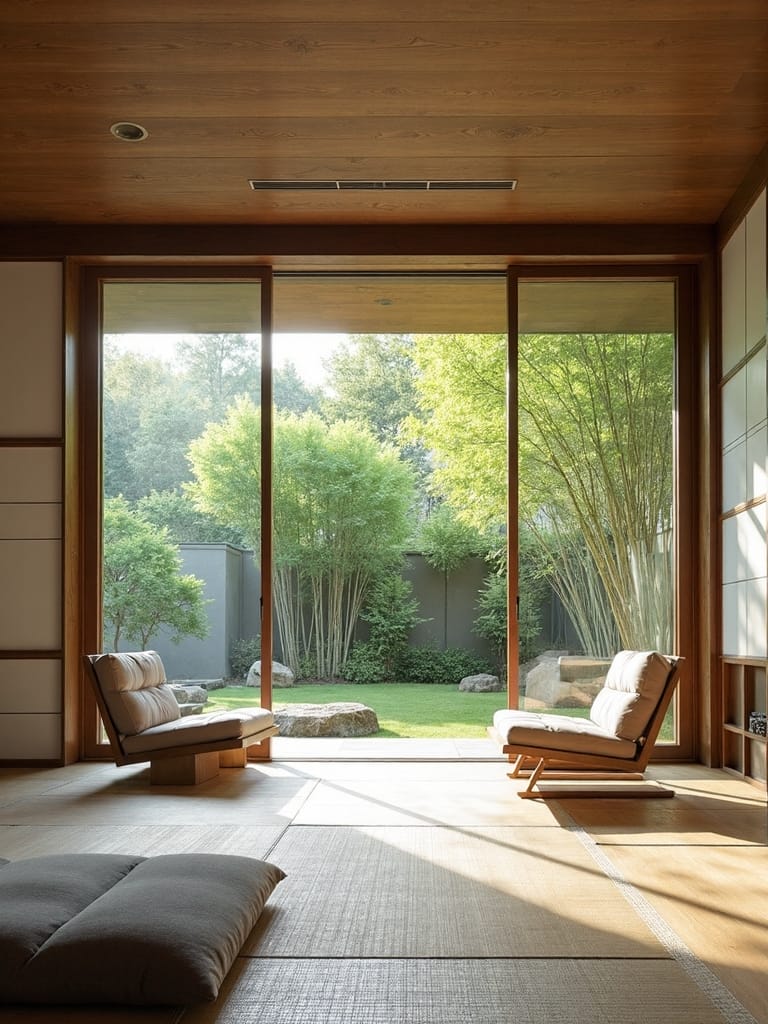
Traditional Japanese design principles beautifully merge indoor and outdoor spaces, creating a harmonious flow that you’ll want to incorporate into your living room.
Create an open flow with large windows and sliding doors that welcome natural light while incorporating modern elements like minimalist furniture. Add natural materials such as wood and stone, along with the sound of flowing water features to establish a calming environment that embodies Zen philosophy.
Modern Interpretations of Traditional Elements

Modern Japanese living spaces brilliantly reimagine centuries-old design elements for today’s homes. You’ll find natural materials like bamboo and cedar creating clean designer lines, while contemporary platform beds and modular storage solutions honor minimalist traditions.
To create a harmonious space, incorporate soft lighting that mimics paper lanterns, and choose a neutral color palette punctuated by nature-inspired accents.
Conclusion
Creating your own Japanese minimalist living room isn’t as challenging as you might think. You’ll find that incorporating natural light, decluttered spaces, and organic materials alters your living area into a peaceful sanctuary. By adding shoji screens, meditation corners, and elements that honor wabi-sabi philosophy, you’re well on your way to designing a Zen space that’ll bring tranquility to your daily life.

